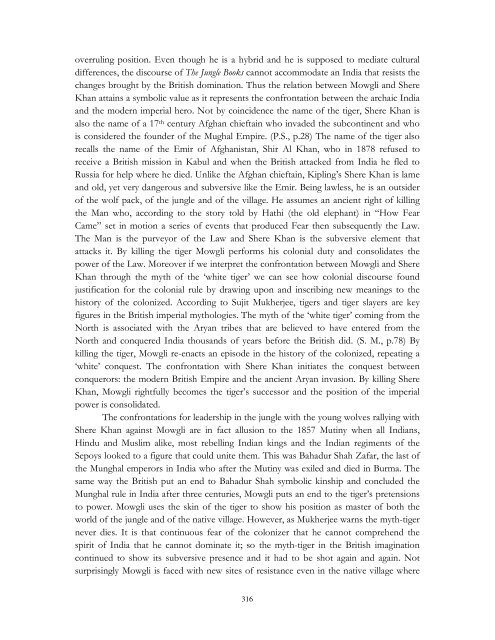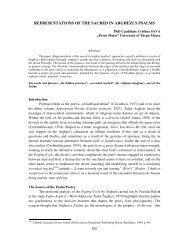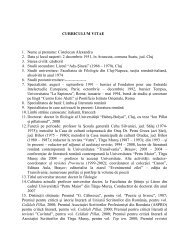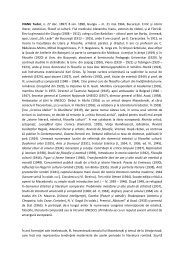- Page 1 and 2:
STUDIA UNIVERSITATIS “PETRU MAIOR
- Page 3 and 4:
STUDIA UNIVERSITATIS „PETRU MAIOR
- Page 5 and 6:
NEVESTE SIMBOLISTE (Agatha) Al. CIS
- Page 7 and 8:
cadrul simbolismului şi al moderni
- Page 9 and 10:
alintate nici nu poate fi altul dec
- Page 11 and 12:
giganticele înfăptuiri/ De azi”
- Page 13 and 14:
RADU STANCA. LIRISMUL SPECTACULAR I
- Page 15 and 16:
cu un apetit devorator. În limba d
- Page 17 and 18:
într-un joc estetic de o supremă
- Page 19 and 20:
fim/ Eu creanga ta de aur, tu frunz
- Page 21 and 22:
sub monoclu/ Şi-ntregul picior câ
- Page 23 and 24:
CONLOCUIREA OMULUI CU ISTORIA Dorin
- Page 25 and 26:
care intră structurile de tip form
- Page 27 and 28:
existenţială poate face ca evenim
- Page 29 and 30:
de cauzalitate” (ibidem, p. 214).
- Page 31 and 32:
implicaţii mistice din creaţia lu
- Page 33 and 34:
existenţei individuale cu seriile
- Page 35 and 36:
Carnavalizarea morţii. Carnavaliza
- Page 37 and 38:
„Calidorul” lui Paul Goma este
- Page 39 and 40:
TERMINOLOGIA LEXICALĂ ŞI DISCURSI
- Page 41 and 42:
(trupurilor solide), fluidele licvo
- Page 43 and 44:
(chir.) ale sulfului cu arsenicul;
- Page 45 and 46:
vro proprietate noă, sufer numai n
- Page 47 and 48:
Referinţe bibliografice Bidu-Vrăn
- Page 49 and 50:
CATEGORII SUBTILE ALE SPAŢIULUI MI
- Page 51 and 52:
aşezate una lângă alta, cu feres
- Page 53 and 54:
„superstiţiile şi credinţele d
- Page 55 and 56:
spre nord, arta textilă a Finlande
- Page 57 and 58:
până la manelele de astăzi. Dar
- Page 59 and 60:
30. Ibidem. p. 144 31. Ibidem. p. 1
- Page 61 and 62:
privind până şi statutul acestei
- Page 63 and 64:
universală, prin a ne ajuta să ne
- Page 65 and 66:
totalitate, deşi unele ţin deja d
- Page 67 and 68:
mai largă de utilizare. Ele sunt l
- Page 69 and 70:
anumite date. De exemplu: asl, pls!
- Page 71 and 72:
Cory. App, georgi o fi scris l ist
- Page 73 and 74:
ANEXA Abrevieri de origine engleză
- Page 75 and 76:
acel set ierarhizat de trăsături
- Page 77 and 78:
cronotopică ce duce spre sensul hi
- Page 79 and 80:
timp al celebrării fiinţei: luna
- Page 81 and 82:
(1990, FP/Sandaua lui Marc-Aureliu:
- Page 83 and 84:
manifestând aspiraţie, elan exist
- Page 85 and 86:
Articole Chiorean, Luminiţa, „No
- Page 87 and 88:
PRINCIPII LINGVISTICE DE PREZENTARE
- Page 89 and 90:
are un număr mare de sensuri, el e
- Page 91 and 92:
acestea urmează să fie explicate
- Page 93 and 94:
eventual pericol prin vorbe” şi
- Page 95 and 96:
aşezat peste livezi - vinul s-a a
- Page 97 and 98:
Evseev, I. Semantica verbului. Timi
- Page 99 and 100:
Natura verbală e demonstrată prin
- Page 101 and 102:
este considerat a realiza funcţia
- Page 103 and 104:
Bidu-Vrânceanu, Angela, Călăraş
- Page 105 and 106:
complement circumstanţial: de scop
- Page 107 and 108:
MODALITĂŢI DE TRANSFER AL CUNOŞT
- Page 109 and 110:
Caracteristici de bază: • rus-ro
- Page 111 and 112:
Eforturile Centrului Naţional de T
- Page 113 and 114:
O înregistrare terminografică din
- Page 115 and 116:
ş.a.), iar în etapele următoare,
- Page 117 and 118:
RETORICA ANTILIMBAJULUI ŞI SENSURI
- Page 119 and 120:
evoluţia fiintei : principala meto
- Page 121 and 122:
Dincolo de avatarurile personajelor
- Page 123 and 124:
Modalităţile laice de eliberare a
- Page 125 and 126:
Morus 1958: Thomas Morus, Utopia, t
- Page 127 and 128:
întrebării socratice, dar mai ale
- Page 129 and 130:
psihologic, ideea de bază a deprin
- Page 131 and 132:
filosofică sau filosofarea ne sunt
- Page 133 and 134:
. uşurinţa transcrierii / lecturi
- Page 135 and 136:
situaţii, stări, atitudini, imagi
- Page 137 and 138:
• Ce este noaptea ? • Ce este t
- Page 139 and 140:
ASPECTE PRIVIND RELAŢIA ADJECTIVUL
- Page 141 and 142:
Identificarea corectă a cazurilor
- Page 143 and 144:
g. Capacitatea de a apărea în enu
- Page 145 and 146:
Note • Neamţu, G. G., Teoria şi
- Page 147 and 148:
are particularitatea că se află
- Page 149 and 150:
Dar ce atitudine s-ar potrivi, atun
- Page 151 and 152:
obiectiv, cu bifarea lui în decemb
- Page 153 and 154:
aţionalitatea neconcesivă, pruden
- Page 155 and 156:
„Aşa că se răzbună şi el cum
- Page 157 and 158:
problemelor reale, a dramelor auten
- Page 159 and 160:
Pentru că încercam să aproximăm
- Page 161 and 162:
Note: 1 Monica Lovinescu, Pragul. U
- Page 163 and 164:
Să vedem cum stau exact lucrurile
- Page 165 and 166:
Revenind la fata de împărat, odat
- Page 167 and 168:
Note 1 Claude Bremond, Logica poves
- Page 169 and 170:
Dans cette phase initiale du voyage
- Page 171 and 172:
La première étape est définie pa
- Page 173 and 174:
Ou encore : La nuit qui vient, le v
- Page 175 and 176:
dans quelques jours quand nous nous
- Page 177 and 178:
Conclusion En modelant les points d
- Page 179 and 180:
12 Dans la culture occidentale, l
- Page 181 and 182:
feuilletage », qui a pour mission
- Page 183 and 184:
son âne : [il] le frappait avec so
- Page 185 and 186:
puisse voir des magasins offrant de
- Page 187 and 188:
un insigne qui le montre ; c’eût
- Page 189 and 190:
obtenu par l’emploi massif de on,
- Page 191 and 192:
femmes, enfants - dans un lieu publ
- Page 193 and 194:
donner. que dans une année mauvais
- Page 195 and 196:
Pourquoi Les Diaboliques ? Parce qu
- Page 197 and 198:
Dans la vision de l’écrivain le
- Page 199 and 200:
Dans ses illustrations pour Les Dia
- Page 201 and 202:
LE RÉCIT POÉTIQUE Alexandru LUCA
- Page 203 and 204:
L’autre approche est pragmatique,
- Page 205 and 206:
Bibliographie MAINGUENEAU D., Embra
- Page 207 and 208:
chemin de terre est « toujours bou
- Page 209 and 210:
Néanmoins, la connotation négativ
- Page 211 and 212:
périphérique qui mène vers l’h
- Page 213 and 214:
POEZIA FEMININĂ RUSĂ - O ABORDARE
- Page 215 and 216:
scrierile sale pasionale, de formul
- Page 217 and 218:
Istoria literaturii ruse de la sfâ
- Page 219 and 220:
integrare socială, consideră Jacq
- Page 221 and 222:
prin plăcerea de a scrie, plăcere
- Page 223 and 224:
măiestria/Vdohnovenie i masterstvo
- Page 225 and 226:
secole şi mai bine poezia rusă a
- Page 227 and 228:
13 I. Odoevţeva, На берега
- Page 229 and 230:
Da, suntem o catedrală, nu încape
- Page 231 and 232:
Continuând periplul emoţional al
- Page 233 and 234:
Zări să-şi facă din pridvor, s
- Page 235 and 236:
Painting by Formula The heyday of O
- Page 237 and 238:
and Germany. She is throwing back t
- Page 239 and 240:
ebellious thoughts. With imaginatio
- Page 241 and 242:
sealed lips mean that they keep man
- Page 243 and 244:
DelPlato, J. 2002, Multiple Wives,
- Page 245 and 246:
LEARNING OR ACQUIRING? FOREIGN LANG
- Page 247 and 248:
knowledge. At the Millennium, just
- Page 249 and 250:
During 12 years in public education
- Page 251 and 252:
9. Bibliography 1, Kurtán Zsuzsa
- Page 253 and 254:
'CAN’T YOU HEAR THE SHOOTING?' -
- Page 255 and 256:
hegemony. State induced violence th
- Page 257 and 258:
ecause it is in anyway more remarka
- Page 259 and 260:
affronts, offends or questions our
- Page 261 and 262:
Nye’s poem the death of Ibtisam B
- Page 263 and 264:
28 The N.O.M.A.D.S., “Moot.” Po
- Page 265 and 266: associated with speech, “apparent
- Page 267 and 268: elevant to phonetic interpretation.
- Page 269 and 270: structures, which are often quite a
- Page 271 and 272: Several questions arise regarding w
- Page 273 and 274: not discriminated in any sense. Col
- Page 275 and 276: on the political domain and the 196
- Page 277 and 278: COGNITIVE VS. COCK-NITIVE MAPPING O
- Page 279 and 280: uined Europe gradually becoming our
- Page 281 and 282: wounded. In a novel published in 19
- Page 283 and 284: texts are to be seen as discourses
- Page 285 and 286: […] I would like to show that “
- Page 287 and 288: Consequently, a discourse makes sen
- Page 289 and 290: Marx, Karl, The German Ideology in
- Page 291 and 292: The body copy of Sony advertisement
- Page 293 and 294: and intensity: ”impecable”, „
- Page 295 and 296: A COMPARATIVE ANALYSIS OF THE ROMAN
- Page 297 and 298: problems could be solved. This posi
- Page 299 and 300: Figure 1 Hofstede’s Cultural Dime
- Page 301 and 302: more assertive and competitive, wit
- Page 303 and 304: Notes: 1 http://family.jrank.org 2
- Page 305 and 306: term called textualisation strategi
- Page 307 and 308: theory of macrostructures are typic
- Page 309 and 310: to make them easily accessible. Pre
- Page 311 and 312: theory of language alone cannot com
- Page 313 and 314: functioning as a purveyor of the im
- Page 315: aboriginal Indians, the pre-Aryan c
- Page 319 and 320: Identity is indeed an open concept.
- Page 321 and 322: outside, which implies bringing the
- Page 323 and 324: Wieseltier advances the idea of ide
- Page 325 and 326: TRADUCEREA ŞI DIHOTOMIA ’FIDELIT
- Page 327 and 328: Printre cei care susţin fidelitate
- Page 329 and 330: textul tradus de orice conotaţie c
- Page 331 and 332: CONTROVERSIAL ISSUES OF SLANG. LEXI
- Page 333 and 334: There are several slang words that
- Page 335 and 336: to the acceleration of this process
- Page 337 and 338: COMPANY NAMING (When names speak vo
- Page 339 and 340: - simple spelling and conveying som
- Page 341 and 342: avantimediagroup.com, Avanti Media
- Page 343 and 344: KEY LINGUISTIC CHARACTERISTICS OF B
- Page 345 and 346: doctors, as well as discussing with
- Page 347 and 348: The learner may know the ‘general
- Page 349 and 350: 6. Pickett, D. (1989). English in B
- Page 351 and 352: Abderrahman Beggar, L’Épreuve de
- Page 353 and 354: Aliona Grati, Privirea Euridicei. L
- Page 355 and 356: ar merge, tocmai, cu cît ar merge
- Page 357 and 358: Sanda Cordoş (coord.), Spiritul cr
- Page 359 and 360: aserţiune e provocatoare şi este
- Page 361 and 362: centrale, de la Comitetele de lectu
- Page 363 and 364: îmbină într-un mod original tehn
- Page 365 and 366: poziţie înaltă în structura con
- Page 367 and 368:
The material analyzed can be studie
- Page 369:
LISTA AUTORILOR Vasile Bahnaru, Ins
















